Abstract
The article provides fundamentally important aspects of religious tourism and its varieties. The classification of religious touts has been made according to different criteria. The attempt to draw a clear separation between the concepts of “religious tourism” and “pilgrimage” has been made. Finally the main religious and cultural resources of the Republic of Tatarstan have been enlisted to prove that taking a religious tour to the place where several confessions live side by side peacefully can put a wonderful example for other multinational territories. It has been shown that such kind of tourism undoubtedly contributes to the social tension relief and development and strengthening of intercultural tolerant interaction between ethnic groups, nationalities and citizens of different countries. Occupying its own niche in the range of tourist offers, religious tourism is inextricably linked with other types of tourism and has much in common with them in organization methods. Therefore, the activity on the organization of religious tourism as an actively developing segment of the modern internal and international tourist market is considered in detail. Examples of routes have been given, characteristics and tendencies of the international market of religious tourism have been analyzed.
Keywords: Religious tourismpilgrimagetoleranceintercultural cooperationKazanTatarstan Republic
Introduction
In the past few decades, such trend as religious (pilgrim) tourism has been intensified in the tourism market. Religious tourism is commonly associated with visiting religious shrines, spiritual cultivation, getting accustomed with the customs, traditions, festivals and rites of different denominations’ representatives. Such kind of tourism undoubtedly contributes to the development and strengthening of intercultural tolerant interaction between ethnic groups, nationalities and citizens of different countries. The Republic of Tatarstan, a subject of the Russian Federation, can serve as an undoubted example of tolerance that has created a strong foundation for the entire life of the multinational people of the republic. According to the recent statistic data, presented at the site of State Committee on Tourism of the Republic of Tatarstan, the republic’s population is 3, 89 million people speaking two state languages: Russian and Tatar.
Tatarstan is one of the most multi-ethnic areas of Russia. Representatives of over 115 ethnic groups live in the republic, including 8 nationalities, the number of which exceeds 10 thousand people: Tatars, Russians, Chuvashes, Udmurts, Mordovians, Maris, Ukrainians and Bashkirs.
People with various historical and cultural traditions live in the republic. The combination of at least three types of cultural interaction (Turkic, Slavic-Russian and Finno-Ugric) defines the uniqueness of this area, identity of cultural and historical values.
The traditional religions of the republic are Islam and Christianity. Tatars and Bashkirs (i.e. nearly half of the population of the republic) confess Islam. The other part of population – Russians, Chuvashes, Maris, Udmurts, Mordovians are Orthodox Christians. Catholicism, Protestantism, Judaism and other confessions are also presented in Tatarstan.
Problem Statement
The technological boom that is being experienced now provides tremendous opportunities for people. But often modern gadgets and mobile devices turn out to be destructive and contribute to the development of the cultural crisis and the "loss of meaning" in the public consciousness. We believe that partially the reasons of what is happening lurk in the atheistic Soviet past. For more than 70 years Soviet society lost a powerful means of spiritual and moral education by rejecting religion.
Therefore, nowadays post-Soviet society is in urgent need of tense emotional state relief and moral rebirth. In the recent past, communist Soviet ideology was considered to be the main influencing factor of educational morality in our country. Currently, religion gains increasing influence on the society’s moral norms. People are gradually returning to their origins, looking for ways to learn the truth. It is not surprising that religious tourism, which is able to soften and regulate social relations, to convey the feeling of peace, tranquility and stability is becoming more and more demanded.
Research Questions
We have singled out the following research questions and problems that that need to be solved to achieve the goal:
3.1 Analysis of the main forms of religious tourism, making a clear differentiation between religious tourism and pilgrimage.
The phenomenon of religious tourism, or so-called “Faith Tourism”, has constantly attracted the researchers’ attention and was defined and described in the following ways: “…a form of tourism, whereby people of faith travel individually or in groups for reasons related to religion or spirituality in their quest for meaning. It could be under pilgrimage, missionary, or leisure purposes. Many of today's most popular tourist destinations are related to ancient places of worship or to the site of apparent miracles (Somnuck, 2010).
Amber (2018) in his paper “Religious Tourism – a review of the literature” has searched all papers with the term “religious tourism” via Emerald Insight from January 2006 to December 2017. The search was run in June 2017 for the last time and all early cite papers falling under the criteria were also included. The researcher comes to a conclusion that “… this is a growing field with burgeoning overlaps across many different tourism segments. It is crucial that academics and practitioners realize the dire need to expand the type of research being conducted in this area” (Amber, 2018, p. 152).
This is surprising given the huge economic and socio-political relevance of the topic. Richard, Chandrarathne, & Chandana (2013) mention “the tourism potential of major religious sites and heritage destinations is well understood but often under-estimated […]” (p. 464). The world we live in today not only requires but rather demands that we implement policies which bring us together. Rather than religion being used as a divisive force, the concept of religious tourism can be used by governments to foster visits to places which hold spiritual relevance for multiple religions or viewpoints.
The clue points of religious tourism peculiarities were analyzed and described be the following Russian scientists: Babkin (2008) in his book “Special Types of Tourism”, Birzhakov (1997) “Pilgrimage and Religious Tourism”, Muravyev (1990) “Journey to Holy Places”.
A fundamentally important aspect of this article is the clear differentiation between the concepts of “religious tourism” and “pilgrimage”. The fact is that at present Russian tourist organizations using the normative and legal acts, in most cases, treat these concepts as synonymous ones. But in our opinion pilgrimage and religious tourism are two different types of human activity. Religious tourism is a socio-economic activity, and pilgrimage is a religious one. That is why we suppose these concepts cannot be treated equally.
3.2 Revealing the significance and functions of religious tourism for society and the analysis of the current state of religious tourism in Russia, using it as a basis for analyzing this trend in the Republic of Tatarstan.
Religious tourism is an integral part of the modern tourism industry. Today, more than 90% of objects of tourist interest in the world are in one way or another connected with a cult or religion that are present nowadays or have already lost their meaning or been forgotten.
The intensity of the tourists’ flow traveling around the world for pilgrimage and religious purposes is increasing annually. In the XX century, the tourism industry was booming, the means of transport and communications were improved. People got more opportunities to visit the holy places of "their" religion. Also, the dialogue of cultures intensified in the era of internationalization.
Religious tourism is divided into two main types: pilgrimage and excursion and cognitive religious tourism. The difference these two types lies in the difference in their goal-setting. This fact sets the peculiarities of accommodation and catering for tourists, the specifics of the guided tour route, the choice of display objects, the content and form of the guide tour itself. For example during the cognitive religious tour, hotel accommodation with a wide choiсe of entertainment facilities and modest meals in a restaurant or cafe on fasting days may be insignificant in tour quality assessing. On the contrary, for a pilgrim this fact can cancel all other efforts of the travel agency, create psychological discomfort and emotional stress.
The pilgrim tour includes not only visiting and qualified observation of mosques, churches, monasteries, holy places (springs, etc.), but also the actual participation of a pilgrim in the religious life of the place, the possibility of attending a church service, participation in worshipping and other ceremonials.
In some cases, there are specialized tours in which pilgrims and sightseers can be joined. Specialized tours are usually designed for at least three days with a visit to religious shrines and architectural monuments of the past. Sometimes for the organization of such tours permission (blessing) of the cleric is necessary.
Religious tours can be classified according to various criteria. The main ones are presented in Table
3.3 Exploring the resources of religious tourism in the Tatarstan Republic and identifying its relevance on this territory, analyzing the resources of religious tourism we are going to use the above given criteria.
Conducting research on the range of religious tours offered by tourist enterprises of the Tatarstan Republic, it was revealed that pilgrimage services, temples, cathedrals, monasteries, mosques and some travel agencies such as “Lider Kazan”, “Kazan Travel”, “Tatar Tour”, “Travel and Work” and others specializing in individual and group tourism organize religious tours, mostly short-term. Just two companies specialize in religious and pilgrimage tours, other tours are successfully complemented by a rich guide tour program in Kazan and the Tatarstan Republic. The tourist potential of the region is very promising for religious tourism development. The Republic has got a developed transport network. There are highways, railways, airlines, four navigable rivers: the Volga, the Kama, the Vyatka and the Belaya, oil and gas pipelines.
Speaking about the cultural and religious potential of the region, it is possible to name more than fifteen holy places in the republic, but the article format lets us name just a few ones.
It should be noted that despite the fact that in our country religion is separated from the state, the Republic authorities are in constant search for means and opportunities to restore and repair religious buildings and monuments. State structures, and, above all, the Council for Religious Affairs under the Cabinet of Ministers of the Republic of Tatarstan, provide religious organizations with the necessary assistance in solving many problems. The Council has developed a Law of the Republic “On Religious Organizations”. Besides, a non-commercial organization "Republican Foundation for the Revival of Monuments of History and Culture” headed be the republic’s ex-president Mentimer Shaimiev. For almost ten years the main task of the Foundation has been in the preservation and restoration of the Bulgar Historical and Architectural Museum and the architectural and artistic revival of the State Historical, Architectural and Art Museum "Island-town Sviyazhsk”. These two sites can be named among the most attractive religious tourism attractions.
The ancient city of Bulgar became the center of pilgrimage for Muslims from all over Russia. It was here in 992 that the ancestors of the Tatars - the Volga Bulgars - were the first in Eastern Europe to adopt Islam (Figure
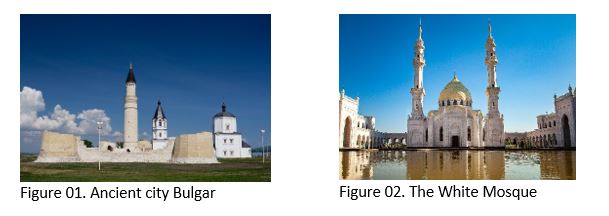
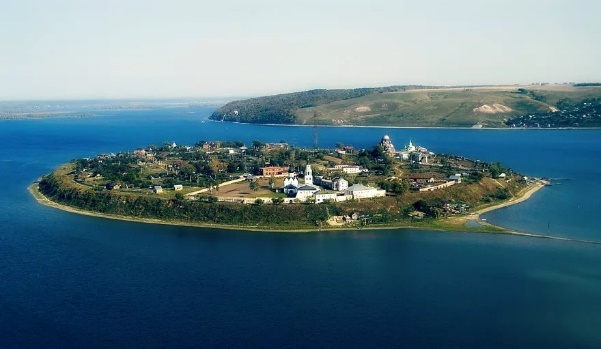
Inside Kazan twelve historical mosques have been preserved in the part of the city that is called Tatar Settlement. All these mosques work nowadays welcoming the believers from all over the city and outside its boundaries.
The complex of the Kol Sharif mosque is the center of attraction for pilgrims of the Islamic faith and not only for them. This is one of the main Muslim mosques in Tatarstan, which is located on the territory of the Kazan Kremlin and is one of the main attractions of the city. Though the mosque is rather modern, its construction began in 1996, and ended in 2005, it is a re-creation of the mosque of the Kazan Khanate, which was destroyed by the troops of Ivan the Terrible during the capture of Kazan.
The reconstruction of the mosque was to coincide with the Kazan millennium celebration in 2005, and it was named after Imam Kol Sharif (Figure
Pilgrimage to Kazan is very popular among residents of the Tatarstan Republic and believers coming here from other regions of Russia and even from abroad.
In addition to the mosque itself, the complex includes museums of Islamic culture of the Volga region, a library, a publishing center, and the imam's administration.
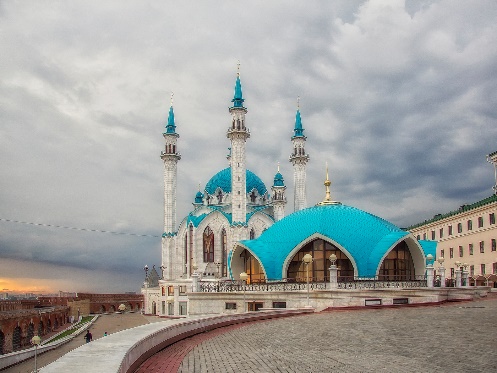
Not far from Kazan Kremlin, pilgrims are especially attracted to the place where the Icon of the Mother of God of Kazan was found. The very same image is kept in the Holy Cross Church (Figure
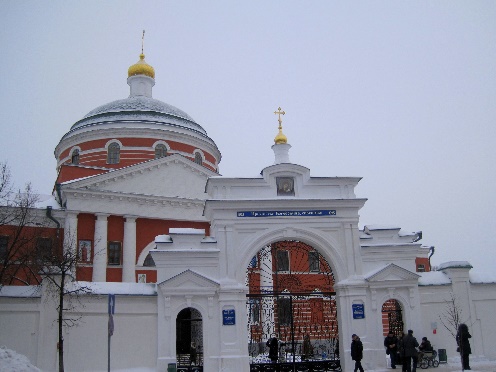
We could not but tell about the wonderful monastery that is located 27 km from Kazan near the city of Zelenodolsk and the Volga-Kama State Nature Reserve. Raifa Monastery was founded in the XVII century by hermit Filaret on the shore of the Sumsky (Raifsky) lake. The share of the monastery, as well as other temple complexes in Russia, fell devastating times, but one of the few managed to preserve almost all of its buildings and values to this day. There are three temples here: the Cathedral in honor of the icon of the Georgian Mother of God (in which the main treasure of the monastery is kept), the Cathedral consecrated in honor of the reverend fathers in Raif and Sinai (Figure
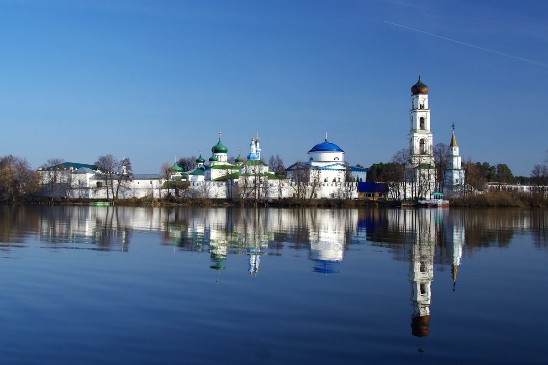
Finally let us mention the place that, in spite of being not an active temple of any religion, is still the unique architectural complex, promoting interconfessional mutual understanding and tolerance. The Temple of All Religions (Figure 07) or the Universal Temple in the Staroye Arakchino district of Kazan consists of several types of religious architecture including an Orthodox church, a mosque, and a synagogue, among others. It is currently under construction since 1992, started by local artist and philanthropist Ildar Khanov. The structure serves as a cultural center and a residence for Khanov and his assistants. It has become a popular landmark in the city of Kazan, which takes pride in the peaceful combination of different cultures (Islamic Tatar culture, Orthodox Russian, and others).
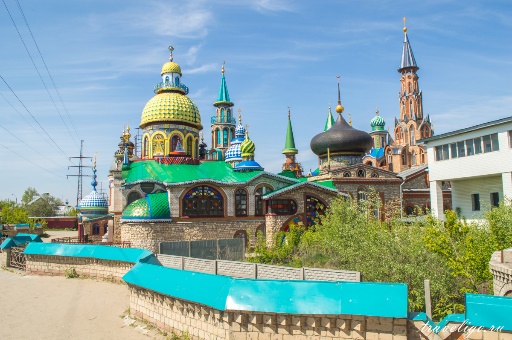
3.4 Defining tourism as “an important factor in strengthening spiritual and cultural respect within nations and between nations”, as UN Secretary-General Ban Ki-moon said in his address to the participants of the international conference on tourism, religions and the dialogue of cultures, organized by the World Tourism Organization (UNWTO), in October 29-31, 2007 in Cordoba (Spain). The conference presented speeches and reports, as well as case studies in three areas: tourism, religion and dialogue of civilizations; religious tourism and the sustainability of religious tourism destinations. The aim of the conference was to determine the interrelationships between tourism and religion, the possibilities of optimizing their synergy and interaction by using the potential of tourism to stimulate and promote dialogue among civilizations, cultures and religions. Guidelines and recommendations were proposed for governments, religious authorities and tourist operators to ensure sustainable development and management of tourism, motivated by religious goals or related to religious heritage sites, as well as opportunities to optimize the benefits such tourism can generate. The holding of this conference demonstrates the importance of religious tourism as educational in the global tourism industry.
Currently, knowledge is the main means of improving society. It helps a person to form his attitude to values and to develop his own worldview on their basis. The worldview-forming approach to the theory and practice of cognition (rather, to practice, considering this subject of work) is a routine, eclectic, individual and social sensual-empirical and religious-mystical experience, including religious mythology, mental-ethnic, folklore, ritual, ritual signs and concepts. It is precisely they, as worldviews, that the initial epistemological principles establish a certain way of life, fill the consciousness and the soul of a person with a certain religious, spiritual - moral, moral and right - serving, as well as aesthetic content. It is this kind of experience that is capable of transmitting religious cognitive tourism through a real-material system, through the practice of traveling.
The active development of religious and cultural trips is associated with the active emergence of people's interest, in particular, Russian citizens, to their historical roots, religions, sacred and memorable places, religious rites and ceremonies. No doubt people from abroad can also be attracted by the promise of tolerant treatment and especially tempted by the possibility to be greeted, guided and informed by means of their native language. Thus, foreign language can also be used while preparing future guides and service sphere specialists to their future professional activities (Ziganshina, Mendelson, & Plastinina. 2013).
Purpose of the Study
The subject of the research is the organization of religious tourism, taking into account its potential for social regulation, tension relief and establishing intercultural communications and contacts by the example of Tatarstan Republic. The layout of a religious tour can be developed on the basis of the results.
Research Methods
When conducting the research the architectural features were analysed. Religious and cross-cultural peculiarities of historical monuments were considered.
Findings
Religious tourism should be defined as trips with educational purposes, a type of educational tourism, as well as activities to organize visits to tourists outside the usual living environment (dwelling), religious and places of interest associated with cultural and natural heritage. Religious tourism brings not only economic benefits to the local population, state structures and private enterprises (not only tourist), religious organizations. The main result is the creation of a climate of mutual understanding between the participants of the trips and the local population to jointly overcome existing problems and tensions in society.
Conclusion
The analysis of the historical development, the state of the international and domestic tourist market and prospects for the development of religious tourism allows us to make the following conclusions:
1. Today many travels can be attributed to travel for religious purposes - religious tourism. Currently, about 90% of objects in the world of tourist interest are related to religion.
2. The ideological component of religious tourism is the alleviation of general social tensions, and not the division of society into hostile sides; the establishment of dialogue and peace between confessions.
3. Religious tourism is one of the areas of work on the spiritual and patriotic education of the population, and especially young people, to familiarize people with the moral values, spiritual and cultural-historical heritage of the Russian people.
5. In the modern world with its numerous problems, it becomes especially obvious that the issues of selection and training of personnel for the organization of religious tourism, taking into account the understanding of the nature of the objects of the show and the ethics of communication between the organizers and representatives of denominations, as well as the development of appropriate methods, form a set of critical tasks require a urgent, serious and informed decision.
6. Religious tourism will help to reduce social tensions, a positive role in the dialogue between cultures, religions and civilizations, if it is based on the close cooperation of tourist, government, religious organizations with the local population of tourist territories.
Acknowledgments
This research did not receive any specific grant from funding agencies in the public, commercial, or not-for-profit sectors.
References
- Amber, G. R. (2018). Amber Gul Rashid Religious Tourism – a review of the literature Journal of Hospitality and Tourism Insights, 1(2), 150–167.
- Babkin, A. V. (2008). Special'nye vidy turizma. Rostov-on-Don: Feniks.
- Birzhakov, M. B. (1997). Palomnicheskij i religioznyj turizm. St. Petersburg: OLBIS.
- Muravyev, A. N. (1990). Puteshestvie po svyatym mestam. St. Petersburg: Kniga.
- Richard, T., Chandrarathne, B., & Chandana, J. (2013). Engaging the rural communities of Sri Lanka in sustainable tourism. Worldwide Hospitality and Tourism Themes, 5(5), 464–476.
- Somnuck, J. (2010). Religious_Tourism_Pilgrimage_and_Cultural_Tourism. Retrieved from: https://www.academia.edu/12252237/Religious_Tourism_Pilgrimage_and_Cultural_Tourism
- Ziganshina, M., Mendelson, V., & Plastinina, S. (2013). The ways to adapt technical university students to their professional activities by means of foreign language. In International Conference on Interactive Collaborative Learning, ICL 2013 (pp. 149–152).
Copyright information

This work is licensed under a Creative Commons Attribution-NonCommercial-NoDerivatives 4.0 International License.
About this article
Publication Date
28 December 2019
Article Doi
eBook ISBN
978-1-80296-075-4
Publisher
Future Academy
Volume
76
Print ISBN (optional)
-
Edition Number
1st Edition
Pages
1-3763
Subjects
Sociolinguistics, linguistics, semantics, discourse analysis, science, technology, society
Cite this article as:
Mendelson*, V., Ziganshina, M., Abutalipova, L., Plastinina, S., & Mudarisov, R. (2019). Religious Tourism As A Means Of Intercultural Interaction And Overcoming Religious Confrontation. In D. Karim-Sultanovich Bataev, S. Aidievich Gapurov, A. Dogievich Osmaev, V. Khumaidovich Akaev, L. Musaevna Idigova, M. Rukmanovich Ovhadov, A. Ruslanovich Salgiriev, & M. Muslamovna Betilmerzaeva (Eds.), Social and Cultural Transformations in the Context of Modern Globalism, vol 76. European Proceedings of Social and Behavioural Sciences (pp. 2230-2239). Future Academy. https://doi.org/10.15405/epsbs.2019.12.04.297
